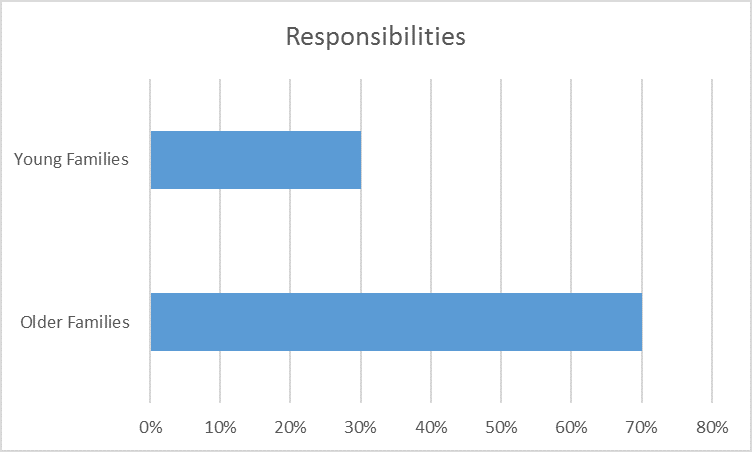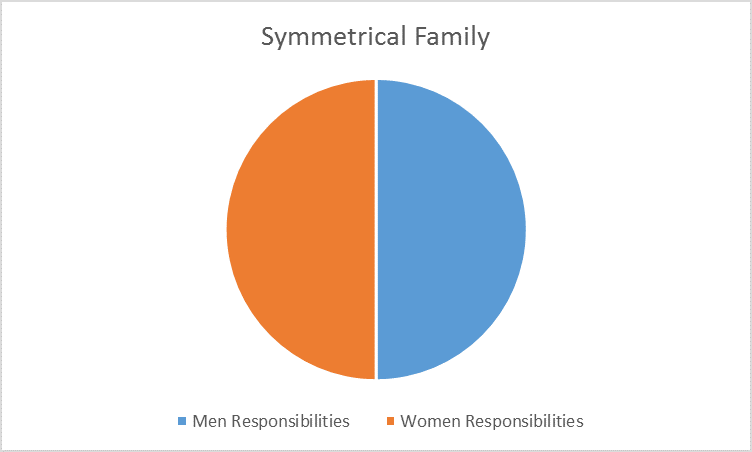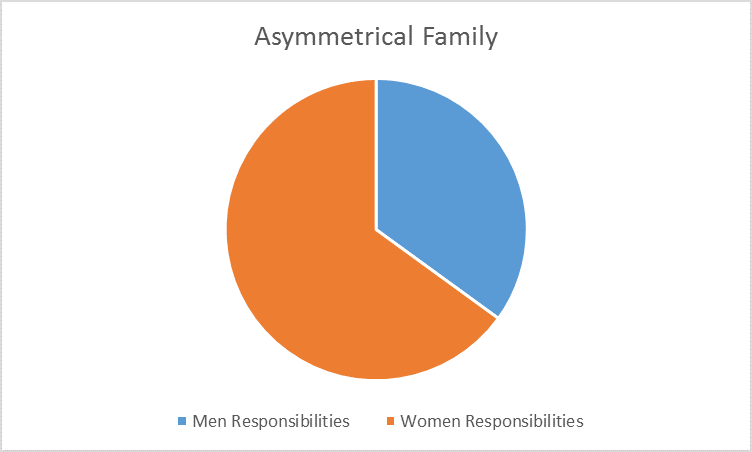Essay on Different Family Roles in Young and Old Families
Number of words: 2017
Conjugal Roles in the Society Today
Introduction
In the contemporary world, the contribution of both men and women is appreciated in society. Conjugal roles involve family responsibilities in the provision of childcare, financial support, and general housework. Over the years, household chores have been defined by gender, with men taking mostly leadership roles while women take care of daily chores. According to sociology, contemporary families have embraced joint conjugal roles characterized by shared duties with minimal differentiation and separation based on tasks (Rözer, 2018). The segregation form of family norms has changed as now shared activities have overwhelmed families. Nowadays, women provide financial support and even take leadership of family finances. On the other hand, men can now cook, take care of children and together with their wives do dishes. Sociologists claim that the shared conjugal roles have promoted family bonds and brought about equality in families, thereby eradicating slavery form of coexistence.
Hypothesis
Today, older men and women do more traditional conjugal roles than younger men and women. There are significance changes in the conjugal roles have been reported by sociologists. Men and women can now share family responsibilities jointly rather than separately.
Aims
The study is aimed at establishing the changes which have emerged in the modern family responsibilities. It will show how in the contemporary society men have swallowed their pride while women have stepped up to uphold families. The study will show the difference between traditional family roles as compared to the changes as sociologists have described.
Case Study
The topic is relevant as it explains how tasks are allocated to family members. In addition, roles are essential to each family as it keeps it functioning effectively. Families believe there are distinct roles for both boys and girls. As a result, the aspect of feminism has raised controversies as girls think what a man can do a woman can do as well. Girls are believed to display excellent performance in their roles, and thus have attained top positions in the job market. The society believes girls tasks are usually done meticulously and effectively. As a result, role allocation has changed. In modern society, both genders have exchanged their roles and what is exceptionally meant for women; men are also doing. The study will cover two aims, which include; to establish what conjugal roles men and women play. Also, it will compare the roles of men and women in young families (ages 18-30) and to men and women in older generations (ages 50-70).
Individuals throughout history have relied on families and the kinship structure for continued existence. This reliance allowed and required that they adapt to projected family roles based on their living conditions. This situation gave families substantial control over its members; however, the situation has changed in the contemporary world as people no longer need families for economic endurance. Planned and unplanned forces have continued to introduce crucial modifications in family roles. For instance, a recent study in different settings reinterprets the historical roles of women in Egypt, medieval Europe, and Native Americans (Oláh, Kotowska, & Richter, 2018). Urbanization, industrial development, and universal economy together with respective communication structures, spread into a country’s families, altering how and where people live, how frequently and what time they have children, and in what ways they work.
Gender roles have influenced how household tasks are distributed in families. In most families, females do house-related chores while males perform outside duties. Also, women undertake lighter functions as compared to men. Today, people perceive roles distribution as gender inequality as they disagree with the determination of what each gender is required to do. The gender scripts sociological concept will be explored in this study, as I attempt to study patterns related to different genders, and how each gender perceives their roles.
Key Concepts
Family roles shape how people interact with one another in the family structure. There are positive and negative features of such tasks, but the essential aspect is to understand ways in which such roles work for the family and ways they assist or harm the family members in their determination to create deep, significant, and safe relations. Joint conjugal roles entail roles carried out by both husband and wife jointly with minimal separation of interests and task differentiation (Bott, 2017). Elizabeth Bott developed this idea in her Family and Social Network (1957). In segregated roles, the husband and wife have defined roles and substantial distinct activities and interests. When assessing the division of labor among families, the functionalist perspective is essential. According to Parson, in most nuclear families, husbands and wives have distinct roles. Men play instrumental roles that emphasize attaining success and attending family financial needs (Parsons, 2016). Wives undertake expressive roles that involve taking care of children, household duties, and focusing on family emotional needs. This model suits women as they are naturally suitable to nurturing family while men are fit as family providers.
Literature Review
In a symmetrical family, responsibilities are shared jointly between partners. Willmott and Young theorized this idea as modern families have adapted. For instance, men and women equally divide household tasks to ensure that no single person takes a triple shift (Young & Willmott, 1974). Young and Willmott developed their perceptions regarding family lives based on functionalist thoughts of sociologists such as Parsons. Through their research conducted in East London, they established modern families are symmetrical, implying that both men and women undertake equal responsibilities compared to Parson’s idea where traditional families segregated tasks. In Young and Willmott’s research, both men and women got paid for work, and both did household tasks like childcare. Furthermore, the research questioned whether husbands help their wives in doing house chores.
An additional idea of both researchers was stratified diffusion, where they argued that values and norms start from richer families and then diffused to other families in society. Thus, they projected next-generation families would be asymmetric since they discovered that wealthier families spent less time with families and segregated family roles (Young & Willmott, 1974). This research was criticized widely by feminist sociologists, especially Ann Oakley. She asserted that the idea of symmetrical families was flawed, as well as data collection. For instance, men’s minimal contribution to household tasks was perceived as reasonable; thus, household tasks were shared equally, hence the symmetrical family (Oakley, 2018). Oakley argues that women did double work, even if they would go out for work, they still did most of the childcare and household chores. Her conclusion stated that women’s employment did not make families symmetrical but implied they had two jobs.
Additional criticisms in the 1970s and today, even though men and women went to work, there was a disparity in payment as women experienced a glass ceiling, thus unable to attain promotions. In addition, it assumes nuclear families with both partners, rather than other different households present in modern society. Young and Willmott’s theory is still relevant today despite criticisms, and symmetrical families’ ideas and segregated or shared gender roles stay valuable methods to consider the gender family labor division.
Methodology
The main objective is establishing the changing conjugal roles. Therefore, I will hand out questionnaires across different Chinese family and do random interviews to hear the feedback of both young and older families to establish the disparity in the conjugal roles over time. I will utilize the positivist approach to provide scientific evidence and reveal how different families operate. This approach is desirable as it focuses on societal ‘evidence’ not ‘evidences’ quantifiable data and scientific approaches. Besides, it is an unbiased and consistent methodology. Quantitative data will provide impartial information that will be used to develop scientific assumptions. In the positivist approach, rules and laws are established, and thus, there is minimal room for error and variances (Taylor, Bogdan, & DeVault, 2015). This makes the study more accurate when it comes to applications and experimentations as it attempts to follow particular guidelines through objective scientific and mathematical tools. However, interpretivists say that in positivist methodology you do not find out the reasons or meanings and so in your research you will not be able to find out about individuals’ reasons for the way they organise conjugal roles in the household.
The snowball sampling method will be used, as this study will require people in the same situation. For instance, I will choose a young family and then ask them to make a referral to some of their friends with young families. It is a suitable sampling method as samples may be hard to find and would, therefore, require referrals. However, I will visit each family and make judgements based on their situations. The approach also enables the researcher to discover different roles which only exist in specific families. When carrying out interviews and administering questionnaires, some questions will include; How old is your family?What particular roles exist in your family? Who is responsible for each of the specific roles mentioned?
Ethics in research will be ensured by acquiring informed consent from the respondents. I will inform them what the research entails and assure them of confidentiality and data integrity (Blackstone, 2018). The acquired data regarding the information acquired from the respondent will be discrete but conclusive. When conducting personal interviews with elderly individuals, I will not make them stand for a lengthy time and ensure the room is comfortable. Older adults have hearing and visual problems so that questionnaires will have a larger font and my voice audible. Since data is for this research, I do not intend to solve whatever conjugal roles conflicts affect sampled families; thus, I will assert my intentions are not to modify or solve any situation regarding family roles.
Results
The information acquired from the questionnaires and interviews shows different family role. For instance, in the contemporary society, men are taking up roles known to be undertaken by women. Now men can wash dishes, look after children as women have taken up financial roles to work and buy family supplies. The study acknowledges the findings of Willmott and Young research regarding symmetrical families where household roles are shared equally among the two genders.
Findings
Roles performed by both kinds of families are presented in the pie chart below:

Roles distribution is symmetrical families according to Young and Willmott research;

Roles in symmetrical families according to sociologist Ann Oakley:

Conclusion
The study concludes that older families have more conjugal responsibilities that young families, and thus the hypothesis is upheld. In symmetrical families, roles are shared equally between men and women, while asymmetrical families, roles are segregated.
References
Blackstone, A. (2018). Principles of sociological inquiry: Qualitative and quantitative methods.
Bott, E. (2017). Urban families: conjugal roles and social networks. In Man in Adaptation (pp. 76-104).
Oakley, A. (2018). The sociology of housework (reissue). Bristol: Bristol University Press. doi:10.2307/j.ctv75d8k9
Oláh, L. S., Kotowska, I. E., & Richter, R. (2018). The new roles of men and women and implications for families and societies. In A Demographic perspective on gender, family, and health in Europe (pp. 41-64). Springer, Cham.
Parsons, J. M. (2016). Gender, class, and food: families, bodies, and health. Springer.
Taylor, S. J., Bogdan, R., & DeVault, M. (2015). Introduction to qualitative research methods: A guidebook and resource. John Wiley & Sons.
Young, M. D., & Willmott, P. (1974). The symmetrical family. Pantheon.
Rözer, J., Mollenhorst, G., & Volker, B. (2018). Families’ Division of Labor and Social Networks in the 21st Century: Revisiting Elizabeth Bott’s Classic Hypotheses. Journal of family issues, 39(13), 3436–3462. https://doi.org/10.1177/0192513X18783230